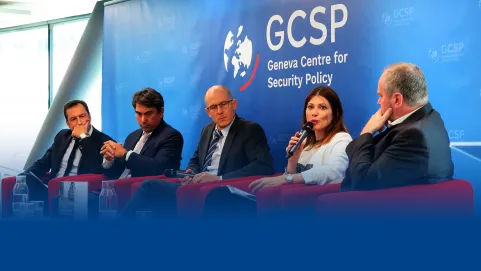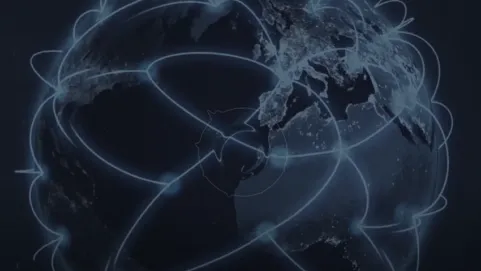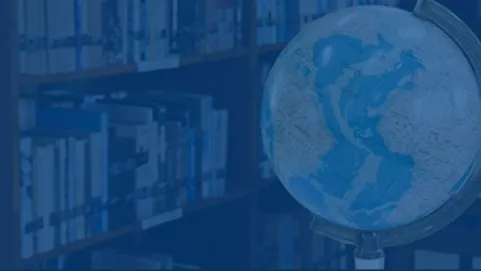Security and Law: A Reality Check
Ms Ashley Müller: Welcome to episode 1 of this mini-series on Responsibility to Protect Revisited. I am Ashley Müller with the GCSP and in this episode, Tobias and Gareth take stock of R2P
Mr Tobias Vestner: So if we delve into the substance, as I said, the concept of responsibility to protect was introduced for the first time in 2001, by the International Commission on Intervention and State Sovereignty, which you had chaired. So in 2005, the World Summit adopted R2P as a doctrine by consensus. And so looking back, it seems that well, that was a major achievement that was really, like a president nowadays would say, that was “huge”. The question then, however, is, well, Was that it? Was the job done? And where do we start now? Where are we standing? How do things look? And especially, are there any lessons or any takeaways from the entire process?
Professor Honourable Gareth Evans: Of course, with the horrors that have happened in Syria and Yemen, and the Rohinga people in Myanmar, and continuing anxiety about so many situations in Africa and elsewhere, it's very, very easy to be cynical, and completely depressed about the state of affairs with the Responsibility to Protect, ery easy to dismiss it as a number of critics now are dismissing it as a complete waste of time, a complete bust. And obviously, there are huge challenges in terms of the effective implementation of the principle’s responsibility to protect, in those very hard cases that have been going so spectacularly wrong. But let's try right from the beginning to put this thing in context by making clear that there are really four separate things that we who created the concept and implemented it initially, were trying to do. And I think against three of those four benchmarks, we're actually not doing too badly at all.
The first benchmark was to try and create a new normative principle that had, hopefully universal acceptance, replacing the previous almost complete indifference of the international community, this belief that atrocity crimes, mass atrocity crimes, genocide, war crimes, crimes against humanity, were simply not everyone's business. But no one's business, that sovereignty was effectively a license to kill, there was nothing much any of us could do about it, we had to cut through that. And that's really the prime objective of crafting the principle and seeking to get it embraced by the international community. And when we look back on the extent to which there has been buy-in to that set of normative principles, I think the story is really a pretty good one. And the best evidence for it are the annual debates that are taking place most recently in the General Assembly, formalised for the first time, not just taking place in a side session, but mainstream chamber mainstream recorded business. And every year since 2009, there have been these debates, and every year, it's been evident that the overwhelming majority of the international community, overwhelming majority of states are completely in support of all three of the R2P principles, namely:
- The responsibility of each state, not to perpetrate atrocity crimes against its own people or allow them to happen.
- Secondly, a responsibility of other members of the international community to assist states that want assistance in meeting that objective.
- And thirdly, the responsibility of the international community, the collective responsibility to respond appropriately, including in extreme cases where the Security Council supports it through military action, where a state is manifestly failing to meet its responsibility to its own people.
All three of those principles are overwhelmingly accepted. Of course, it is the case that the first two principles are much more within the country's comfort zones than the third ones. And that's made very clear over and over again. But there's only a handful of countries and the old familiar’s: the Cuba's, the Nicaragua’s, the Venezuela's, that from the outset have said, we really even though we signed up to it and supported the unanimous decision in the World Summit in 2005. We really think this is an unacceptable intrusion on state sovereignty, you get a little bit of that recurring theme from just a handful of countries. But overwhelmingly, there is support for the basic principles, even from countries like China, who so long have insisted on principles of non intervention, internal affairs and so on. Russia hasn't been very helpful, in the debate, and it started to raise some more generalised objections. But really over the course of R2P history, not even Russia has been a problem when it comes to normative embrace. It's been a big problem in terms of practical implementation, but that's another story. So I think it is very important to recognise that we're in a very different place than the world was in 2001, when our report came out and 2005 when it was unanimously embraced by the General Assembly. I'm not suggesting that any of the things that are involved in those principles have moved beyond principles to the point where they in any way amount to custom international law that would require a much greater degree of buy-in in terms of practical implementation has been the case. I don't pretend that for a moment, but that wasn't the attempt from the beginning. It wasn't to change the law, it wasn't to make new customary law or any other kind of law. It was simply to build on the principles of international human rights and humanitarian law that were already there, the UN Genocide Convention and elsewhere, and win political acceptance for the absolute necessity to do something about these cases when they erupt, so that's the first benchmark.
The second one, I'll be quick about the others. When it comes to operating as an institutional catalyst, a catalyst for effective institutional response. R2P is really done quite well. We now have in 60 countries or governmental organisations, so called RTP focal points, identified officials whose day job it is to monitor these R2P type situations as they're occurring around the world, into mobilising effective response within their own country, their own institution. Admittedly, some of these officials are paying a little bit more lip service to the role than others, but many of them are taking it very seriously. And it does indicate the willingness to give practical content to this otherwise abstract norm. We do have a lot more effective civilian preparedness to deal with engagement assistance support, and ultimately intervention strategies than was previously the case we do have much more military preparedness in terms of so called Mass Atrocity Response Operations (MARO), doctrine training, rules of engagement, this sort of stuff, because military operations, whether in support voluntarily of a country that seeks assistance, or of course, in the extreme case of UN Security Council authorised interventions, military operations in atrocity cases, are not quite the same as traditional Peacekeeping Operations, and certainly not the same as full scale warfighting, they are something in between, there needs to be a whole lot of thinking about how to do this. And that thinking has been occurring. We've also had a significant degree of institutional evolution, of course, with the international judicial system, and in particular, the emergence of the International Criminal Court as a parallel development but a very important one in support of R2P principles. The International Criminal Court has, of course, been under assault from some African countries, some Asian countries like the Philippines, and now grotesquely from the United States with an indefensible assault on the court that's been mounted recently by the Trump administration. But nonetheless, the ICC does deserve and demand respect. It is tenaciously hanging in there. And it's a very important institutional vehicle. And I think R2P has been one of the catalysts for the consolidation of such influence as the ICC has.
The third benchmark against which you have to assess the effectiveness when you're thinking about what we are trying to do is responsibility to protect as a preventive mechanism, an effective preventive mechanism. That's really the heart and soul of all this stuff. And over and over again, the rhetoric of the international community makes clear that's where people's hearts are and properly so. The trouble, of course, with prevention is that when you succeed, nothing visible happens, therefore, nobody notices and it's very hard to ever record success in a way that's seen as credible. But by and large, R2P has been an important energiser for a lot of preventive strategies in a lot of countries. And it's been an important part of the explanation of why there has been no recurrence of atrocities in Kenya since 2008. It's an important part of the explanation why there's been no recurrence of atrocities in a number of West African countries, in Kyrgyzstan since 2010. It's also an interesting and I think, important part of the explanation why a country like Burundi, which for years has been on the edge of a volcano, waiting for another genocidal explosion to occur, it hasn't yet exploded, because every time it gets close to the edge, the Security Council meets, and there's intense scrutiny and discussion and debate about what kind of dampening down strategies and it's all motivated by R2P in a way that would have been unthinkable when we when we go back to the days of Rwanda and the complete indifference of the international community to the evolving horrible situation there. So even though there's a preventive toolbox that is now very well understood, long term structural measures, short term operational measures with a legal and constitutional law, going to economic support or going to Security Sector Developments or whatever. It's a whole bunch of those strategies which are now very much part of people's internalised thinking and planning. So we've come a long way over the last 20 years. And I think R2P has been a big energiser of that attention to preventive strategies.
But where finally the rubber really does hit the road, the fourth benchmark was an effective reactive mechanism when prevention had failed, when atrocities actually occur, will we be able to mobilise the international community to respond effectively to them? Here, of course, the story has at best been mixed. And probably to be objective about it hasn't been really a good story at all. Some good stories, I mean, Côte d'Ivoire, early 2011, Libya in the first part of 2011, well, that went very sour shortly thereafter. Kenya in 2008, the elections that exploded into genocidal violence or potentially genocidal violence, not responded to by any military operation, but by an effective diplomatic mobilisation by Kofi Annan at the UN, the African Union, really classic demonstrations of R2P principles at work, and, you know, pretty successfully applied. But then things went off the rails, it's a long and complicated story, we might get to it. But with Libya in 2011, when what was initially a classic demonstration of R2P, working exactly as it was meant to, with prevention, having failed, situation exploded, Gaddafi engaged in one sided violence against essentially unarmed demonstrators and then mobilising troops to march on Benghazi with the prospect of a massacre of thousands of people. The international community being really energised, mobilised, the Security Council endorsing military response and succeeding in stopping that massacre, but where Libya went wrong. And this is the source of most of the problems I think we got in the Security Council to the present day, where Libya went wrong is what was clearly a very narrowly and carefully defined civilian protection mandate was pocketed and transferred into a full scale regime change mandate, by, frankly, the P3, France, United Kingdom, United States, who said they weren't going to risk content until Gaddafi was actually captured and killed, without thinking through just the implications of that in terms of maintaining trust, confidence consensus on the Security Council. That was seen as going further than the mandate was intended to go. It led immediately to the breakdown of response to the situation which was emerging in Syria at about exactly the same time in 2011. Almost a replica of the Gaddafi situation in the early days in Syria, when you remember Assad began by basically attacking unarmed demonstrators in the Capitol. And instead of the Security Council responding as had been the first step in Libya, with a motion condemning that violence and threatening Criminal Court prosecution and applying arms embargoes or threatening sanctions or applying sanctions instead of the Security Council doing any of those things, there was not even a condemnatory resolution, because basically, Russia, China, India, Brazil, South Africa, all the other members of the Security Council at the time, were so cheesed off with the way in which they thought they had been played by the P3 in the Libya case, they said, we're not even going to let you get to first base on this, we give you guys an inch, you take a mile. And that breakdown, of course, has been catastrophic in its wider implications. Not only did it embolden Assad to go on doing what he did, so that we had a one sided violence turning into a full scale Civil War, which continues to this day. But we had a complete breakdown in the possibility of consensus on the Security Council. And the big task, of course, is to try to recreate that consensus, maybe that's an issue we can come back to.
But that's the bottom line that I want to leave you with, is when you look at those four benchmarks,
- Normative force,
- Institutional catalyst,
- Preventive mechanism,
- Reactive mechanism,
R2P is really alive and well and flourishing in the first three of those not doing so well, in the last, not doing at all well. But don't be disheartened about that. Let's just regard that as a new challenge that we got to try and surmount.
Ashley Müller: That's all we have now for this episode. Thank you to Mr Tobias Vestner and Professor Honourable Gareth Evans for this important conversation on taking stock of R2P. Keep this mini-series rolling and listen to our next episode on the use of force under R2P and responsibility while protecting. In the meantime, don’t forget to subscribe to us on Apple iTunes, follow us on Spotify and SoundCloud. Click the next button to get the next episode!
Listen to Episode 2!
Disclaimer: The views, information and opinions expressed in this digital product are the authors’ own and do not necessarily reflect those shared by the Geneva Centre for Security Policy or its employees. The GCSP is not responsible for and may not always verify the accuracy of the information contained in the digital products.
Featuring
 25 years GCSP: Responsibility to Protect Revisited – Episode 1
">
25 years GCSP: Responsibility to Protect Revisited – Episode 1
">
 25 years GCSP: Responsibility to Protect Revisited – Episode 1
">
25 years GCSP: Responsibility to Protect Revisited – Episode 1
">
 25 years GCSP: Responsibility to Protect Revisited – Episode 1
">
25 years GCSP: Responsibility to Protect Revisited – Episode 1
">
 25 years GCSP: Responsibility to Protect Revisited – Episode 1
">
25 years GCSP: Responsibility to Protect Revisited – Episode 1
">
 25 years GCSP: Responsibility to Protect Revisited – Episode 1
">
25 years GCSP: Responsibility to Protect Revisited – Episode 1
">
 25 years GCSP: Responsibility to Protect Revisited – Episode 1
">
25 years GCSP: Responsibility to Protect Revisited – Episode 1
">
 25 years GCSP: Responsibility to Protect Revisited – Episode 1
">
25 years GCSP: Responsibility to Protect Revisited – Episode 1
">
 25 years GCSP: Responsibility to Protect Revisited – Episode 1
">
25 years GCSP: Responsibility to Protect Revisited – Episode 1
">
 25 years GCSP: Responsibility to Protect Revisited – Episode 1
">
25 years GCSP: Responsibility to Protect Revisited – Episode 1
">



